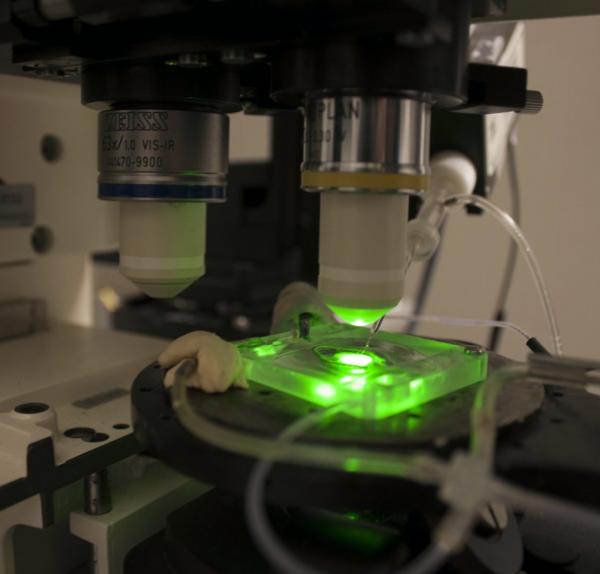Unlocking Brain Function, One Neuron at a Time
The brain’s complexity and how its coordinated actions of billions of neurons shape our behavior and cognition have always fascinated me. So, I decided to go into neuroscience as a career and contribute to biomedical science.
Basic research on neurodevelopmental disorders in model organisms interests me as a way to generate knowledge that could one day translate into improving the lives of individuals with developmental and intellectual disabilities. As a postdoctoral fellow at the NIH, my research aims to understand how the Neuregulin (Nrg)-ErbB4 signaling pathway affects neural circuitry. Neuregulin is an epidermal growth factor-like protein that promotes neuronal migration and differentiation, and previous work has identified the NRG1 gene as a candidate gene for schizophrenia.

My team uses an electrophysiology system to analyze activity in brain cells. The green light allows us to identify GFP-labeled cells that we are studying.
Several questions remain unanswered about how the Nrg-ErbB4 pathway regulates network activity and homeostatic control of normal brain function. We are now starting to explore the physiological mechanisms modulated by this pathway that may provide therapeutic targets for specific neuropsychiatric symptoms.
One of the tools we use to investigate the fundamental properties of diverse types of neurons is patch clamp electrophysiology. This procedure helps determine the biophysical properties of a single, living cell and analyze its electrical activity to understand how cells communicate with each other. Knowing how neurons behave under normal conditions may provide clues to what goes wrong in disease conditions.
Of its several complex structures, the brain’s prefrontal cortex is essential to cognitive control and modulating our thoughts and actions. During my doctoral research, I studied the role of neurotransmitters in cognition and showed that norepinephrine mediates attentional focus and impulsive behavior, which are some of the actions guided by the prefrontal cortex.
Following up on those findings, I studied the effects of norepinephrine on synaptic transmission in the prefrontal cortex using patch clamp electrophysiology. Norepinephrine differentially modulates the cortical neuronal network and is, therefore, influential in decision-making and control of executive functions.

300-micrometer (μm) thick slices of brain cells from a mouse are prepared for analysis.
While my doctoral research provided me with fundamental understandings of neuroscience and experience using different bench skills, I wanted to go further into postdoctoral training to answer some of the more compelling questions about the neural circuitry mechanisms of neurodevelopmental disorders. I particularly chose to come to the NIH, because it is a great place to find diversity and resources for career-development training, like grant writing and teaching opportunities. The Buonanno lab has been an excellent place to get additional hands-on training in many molecular biology techniques and expand my knowledge base on neuropsychiatric disorders.
Blogging about the exciting work happening in the IRP is also an excellent opportunity to engage in discussions on various topics in neuroscience, often involving leading researchers in this field. You can look forward to reading more about developments in brain research in my future posts!!
Related Blog Posts
This page was last updated on Wednesday, July 5, 2023
